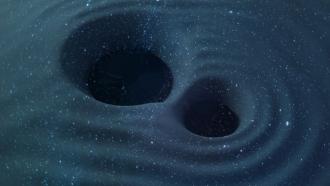![The highest resolution image of the Sun’s surface, showing granular structures, the top of convection cells in the solar plasma. [Image credits: NSO/AURA/NSF] Observations of the Sun’s surface defy present understanding of its interiors](/sites/researchmatters/files/styles/large_800w_scale/public/solar_23jul.jpg?itok=NQ3RLRCC)
The highest resolution image of the Sun’s surface, showing granular structures, the top of convection cells in the solar plasma. [Image credits: NSO/AURA/NSF]
The Sun is composed of dense, hot plasma—a fundamental state of matter consisting of ions and electrons. The plasma is in a continuous mode of convection—where it constantly moves within distinct regions. This movement gives rise to a variety of phenomena occurring on the Sun’s surface, including ‘differential rotation’, where plasma on the equatorial regions of the surface rotate faster than that at poles. In turn, it regulates large-scale solar magnetism—a phenomenon not well-understood.
Over the last several decades, astronomers have studied the Sun in two ways. One is by directly observing it with space-based and ground-based observatories. The other is by numerical calculations of the physics that drives it, on the computer. Despite this, several fundamental questions regarding the solar surface remain unanswered. For example, we do not yet fully understand how differential rotation is set up or sustained. Differential rotation is also observed for other Sun-like distant stars, and its origin remains a fundamental problem of solar physics.
In a recent study, researchers led by Prof. Shravan M. Hanasoge from the Tata Institute of Fundamental Research, Mumbai, assessed how successful computer simulations are in matching with solar surface observations. They concluded that although simulations provide the correct setup of understanding complex phenomena occurring on the Sun’s surface, they are yet to offer a complete understanding of the convection. The study, published in the journal Science Advances, was partly funded by the Department of Science and Technology.
The researchers used observations, spanning over eight years, from a solar observatory called the Helioseismic and Magnetic Imager. It is one of the instruments onboard NASA’s Solar Dynamics Observatory, a space-based observatory dedicated to collecting data on the Sun. The convection of the plasma generates sound waves in the Sun’s interior, which are described by parameters like the wave frequency. The velocity of the convection over different parts of the surface is what astronomers call the flow velocities. From the data, the authors constructed these parameters and studied how they depended on each other.
Simultaneously, the researchers also carried out numerical simulations on computers, to predict the flow patterns from the physics of plasma.
“From observations, all we get to see is what happens on its surface. But, we need to identify what is happening inside it that is giving rise to these flow patterns,” says Prof. Hanasoge. “After measuring the surface, we ask, what is happening in the interior that creates these patterns?”
The researchers observed that the flow velocities are higher at smaller scales. Moreover, the flow was primarily centred at low latitudes of the Sun. The numerical simulations, however, predicted exactly the opposite. While the flow velocities decreased at smaller scales, the flow itself was more pronounced at higher latitudes of the Sun.
“No one has been able to provide a robust explanation for how differential rotation is produced and sustained, and it remains a deep mystery,” shares Prof. Hanasoge.
Convection is a process that requires considering complex structures in both space and time, and the discrepancy could be arising from the limitations of the current numerical simulations. “It is not possible for numerical simulations to capture complexity across the entire range of scales in the Sun, which extend from hundreds of meters to hundreds of thousands of kilometers,” he explains.
Any theory on the dynamics of convection should both describe large-scale phenomena like differential rotation, as well as explain details of the complexities like the increase of the flow velocity at smaller scales, as the Sun shows. Such a theory still remains to be determined. This disagreement provides an opportunity to build an informed understanding of solar physics.
As Prof. Hanasoge points out, “Although we cannot capture everything on the computer, it would be very useful if we could to model just the large scales accurately.”
This article has been run past the researchers, whose work is covered, to ensure accuracy.






